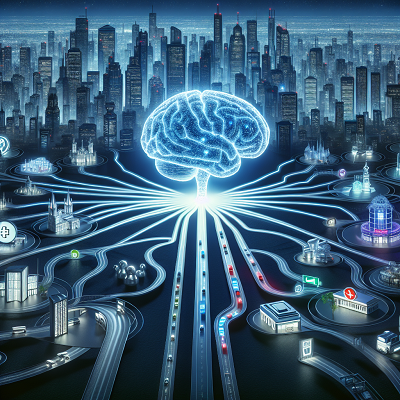Artificial Intelligence (AI) has revolutionized numerous sectors, offering unprecedented capabilities in critical decision-making scenarios. From healthcare to finance, and law enforcement, AI’s potential to transform industries is immense. However, this transformative power comes with significant ethical considerations. This blog delves into the promise and perils of AI in decision-making, exploring key ethical concerns such as bias, transparency, accountability, privacy, and the indispensable role of human judgment.
The Promise and Perils of AI in Decision-Making
AI’s capabilities in critical decision-making scenarios are vast and varied:
- Healthcare: AI can analyze complex medical data to assist in diagnosing diseases, predicting patient outcomes, and personalizing treatment plans.
- Finance: AI algorithms can detect fraudulent activities, optimize trading strategies, and provide personalized financial advice.
- Law Enforcement: AI tools can predict crime hotspots, analyze surveillance footage, and assist in criminal investigations.
Potential Benefits
- Efficiency: AI can process vast amounts of data quickly, reducing the time required for decision-making.
- Accuracy: AI systems can identify patterns and insights that may be missed by human analysts.
- Data-Driven Insights: AI can leverage data to make informed decisions, potentially leading to better outcomes.
Risks and Challenges
- Bias: AI systems can perpetuate and even exacerbate existing biases present in the data they are trained on.
- Transparency: The decision-making processes of AI systems can be opaque, making it difficult to understand how conclusions are reached.
- Accountability: Determining who is responsible for AI-driven decisions can be complex, especially when outcomes are harmful.
Bias and Fairness: Ensuring Equitable Outcomes
Algorithmic bias is a significant concern in AI decision-making. Bias can originate from various sources, including:
- Biased Data: Historical data used to train AI models may reflect existing prejudices and inequalities.
- Flawed Models: The design of AI algorithms can inadvertently introduce biases.
Real-World Implications
Several case studies highlight the impact of biased AI decisions:
- Healthcare: AI systems have been found to underdiagnose certain conditions in minority populations due to biased training data.
- Criminal Justice: Predictive policing algorithms have disproportionately targeted minority communities, leading to over-policing and unjust outcomes.
Strategies for Mitigating Bias
- Diverse Data Sets: Ensuring that training data is representative of all demographic groups.
- Regular Audits: Conducting frequent evaluations of AI systems to identify and address biases.
- Inclusive Design Processes: Involving diverse stakeholders in the development of AI technologies.
Transparency and Explainability: Building Trust
Transparency in AI decision-making is crucial for building trust and ensuring accountability. Techniques to enhance transparency include:
- Explainable AI (XAI): Developing AI models that provide clear and understandable explanations for their decisions.
- User-Friendly Interfaces: Designing interfaces that allow non-experts to comprehend AI decisions.
Regulatory Frameworks
Regulatory frameworks and standards play a vital role in promoting transparency. For example:
- GDPR: The General Data Protection Regulation in the EU mandates that individuals have the right to understand automated decisions affecting them.
- AI Ethics Guidelines: Various organizations have developed guidelines to ensure ethical AI practices, emphasizing transparency and accountability.
Accountability and Responsibility: Who’s to Blame?
Determining accountability for AI-driven decisions involves several legal and ethical considerations:
- Liability: Establishing who is liable when AI systems cause harm.
- Oversight: Implementing mechanisms to oversee AI systems and their developers.
- Governance: Developing governance structures to ensure responsible AI use.
Accountability Mechanisms
Examples of accountability mechanisms in practice include:
- Human-in-the-Loop Systems: Involving human oversight in AI decision-making processes.
- Audit Trails: Maintaining detailed records of AI decisions to facilitate accountability and traceability.
Privacy and Data Security: Protecting Sensitive Information
AI systems often rely on vast amounts of personal data, raising significant privacy and security concerns. Ethical considerations include:
- Data Privacy: Ensuring that personal information is collected, stored, and used responsibly.
- Data Security: Protecting data from unauthorized access and breaches.
Best Practices for Safeguarding Information
- Data Anonymization: Removing personally identifiable information from data sets.
- Encryption: Using advanced encryption techniques to secure data.
- Access Controls: Implementing strict access controls to limit who can view and use data.
Balancing Data Access and Privacy
Finding a balance between data access and privacy rights is crucial. While data is essential for AI development, it is imperative to respect individuals’ privacy and consent.
The Human Element: Balancing Automation with Human Judgment
Despite AI’s capabilities, human oversight remains essential in decision-making processes. Scenarios where human judgment is irreplaceable include:
- Complex Ethical Decisions: Situations requiring nuanced ethical considerations that AI may not fully grasp.
- Unpredictable Contexts: Circumstances where unforeseen factors play a critical role in decision outcomes.
Collaboration Between AI and Human Experts
Combining AI’s data-driven insights with human expertise can enhance decision quality. This collaboration ensures that AI supports, rather than replaces, human judgment.
Future Directions: Ethical AI for a Better Tomorrow
The future of ethical AI lies in continuous innovation and interdisciplinary collaboration. Emerging trends and innovations include:
- Interdisciplinary Collaboration: Bringing together experts from various fields to address ethical challenges in AI.
- Ethical AI Development: Focusing on creating AI systems that prioritize ethical considerations from the outset.
Vision for the Future
The goal is to develop AI systems that support ethical and equitable decision-making, ensuring that AI benefits all of society. By addressing ethical dilemmas proactively, we can harness AI’s potential while safeguarding fundamental human values.



